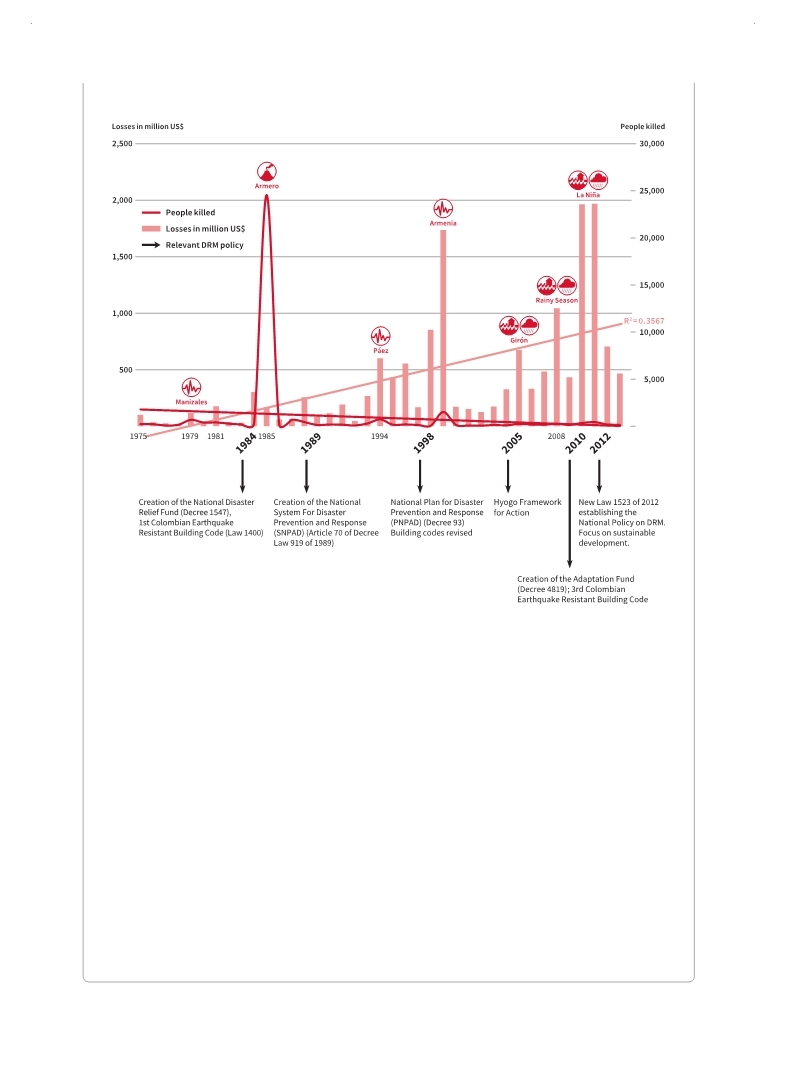 |
Global Assessment Report on Disaster Risk Reduction 2015
Making development sustainable: The future of disaster risk management |
 |
Global Assessment Report on Disaster Risk Reduction 2015
Making development sustainable: The future of disaster risk management |
|
|

34
Chapter 1
While responsibilities had been decentralized, local governments often lacked commitment as well as financial and technical capacities. Adoption and implementation of local disaster risk management plans was limited to larger urban centres, creating dependency on the national level. Risk transfer mechanisms were not in place, nor were clear risk financing strategies. This meant that specialized agencies like the Fund for the Reconstruction and Social Development of the Coffee-Growing Region (FOREC) had to be created after major disasters such as those associated with the 1999 earthquake, which weakened the national disaster risk management agency. At the same time, that agency had been moved from the President’s office to the Ministry of the Interior, reducing its political leverage and influence.
Disaster risk management was interpreted primarily in terms of disaster preparedness and recovery rather than risk prevention and reduction. The mainstreaming of disaster risk considerations into land-use planning, environmental management, and economic and social development planning was more symbolic than real. Involvement of the private sector was limited, and there was an overall lack of accountability. In 2012, those deficiencies were addressed in a new law (INGENIAR, 2010 INGENIAR. 2010,Programa de Reducción de la Vulnerabilidad Fiscal del Estado ante Desastres Naturales, Apoyo al Fortalecimiento de las Políticas e Instrumentos Financieros del Sistema Nacional para la Prevención y Atención de Desastres (SNPAD) de Colombia -DGR-. Documento con bases de formulación de la política (Documento técnico síntesis de soporte para. . Government of Colombia. 2012,Ley No, 1523 del 24 de Abril de 2012. Por el cual se adopta la política nacional de gestión del riesgo de desastres y se establece el sistema nacional de gestión del riesgo de desastres y se dictan otras disposiciones.. . Figure 1.7 Disaster risk reduction and loss trends in Colombia (in constant 2012 US$)9
(Source: UNISDR with data from national loss databases; World Bank, 2012
World Bank. 2012,Analysis of Disaster Risk Management in Colombia: A Contribution to the Creation of Public Policies, Coordinators and Editors: Ana Campos G., Niels Holm-Nielsen, Carolina Díaz G., Diana M. Rubiano V., Carlos R. Costa P., Fernando Ramírez C. and Eric Dickson. The World Bank and GFDRR, Washington, D.C.. . of Colombia, 2010; Colombia HFA Report 2011-2013; López, 2009
López, Juanita. 2009,La construction sociale du risque à Medellin (Colombie): Gouvernance locale et représentations, Thèse pour l’obtention du grade Docteur en EHESS. Paris.. . AIS (Asociación Colombiana de Ingeniería Sísmica). 2014,Historia, Available from http:// www. asosismica.org.co/?idcategoria=1052. Accessed 30 September 2014.. . |
 
Page 1Page 10Page 20Page 24Page 25Page 26Page 27Page 28Page 29Page 30Page 31Page 32Page 33Page 34Page 35->Page 36Page 37Page 38Page 39Page 40Page 41Page 42Page 43Page 44Page 45Page 46Page 47Page 48Page 50Page 60Page 70Page 80Page 90Page 100Page 110Page 120Page 130Page 140Page 150Page 160Page 170Page 180Page 190Page 200Page 210Page 220Page 230Page 240Page 250Page 260Page 270Page 280Page 290Page 300Page 310
|
|
 
|
 
|
